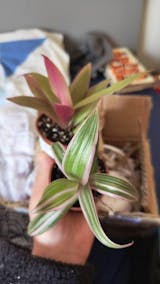




Peanut Cactus - Chamaecereus silvestrii
Scientific Name
Chamaecereus silvestrii (Woodland plant like a candle from the ground)
Common Name
Peanut Cactus
Origin
Originates in Northwestern Argentina and Bolivia
Description
In its native South America, the Peanut Cactus grows in mats on the ground, spreading and trailing as large as a foot wide! Our specimens are babies, and will grow only a few centimetres per year at most; at this size you can still see where they get their common name from. Like many desert cacti, the Peanut Cactus will appreciate your sunniest windowsill and needs its soil to dry out totally between waters. When watering, think about giving it a big shower after months of drought- this is the environment this plant has adapted to!
Light
Thrives best in bright light; will love your brightest windowsill (try South-facing if in doubt!).
Water
Allow all the soil to dry out between watering; if the plant becomes crispy it may have too much sun and too little water; if it starts to grow mushy or rot at the roots, likely too much water and too little sun.
Humidity
Low humidity is perfect for cacti; a hose down to clean now and again is fine as long as the plant dries and doesn't sit damp.
Soil
Needs a well-draining pot and potting mix; look for specific 'cacti and succulent' soils with plenty of sand and other well-draining materials. Only repot if absolutely necessary: use the next size pot up, repot in the spring, and no more frequently than every three years.
Food
Feed every two months in the growing season, and every three in autumn and winter. Use 'cactus' labelled feed.
Temperature
Likes temperatures of 10-28°C; on the warmer end in spring-summer and preferably around 12°C in its autumn-winter dormancy period.
Pet-safe
These plants are not toxic but the more spiky varieties can hurt pets and small humans
Sprouts Top Tips
Sunlight gets a lot less intense when it passes through a window, so make sure you put your cactus in the sunniest spot you have- South or Southwest facing will be your best bet. They are not too sensitive to temperature but be aware that, in cooler weather, the soil will dry out slower- so water less frequently in autumn and winter!






